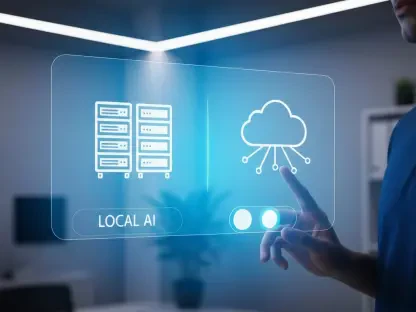Imagine a world where a fleeting idea for a software project can be transformed into functional code with minimal manual effort, where an AI companion not only writes the code but also crafts detailed requirements and test cases to ensure quality. This is the ambitious vision behind a new tool from Amazon Web Services (AWS) that has captured the attention of developers worldwide. Built on a forked version of Visual Studio Code (VS Code), this innovative Integrated Development Environment (IDE) leverages the power of Claude Sonnet AI (versions 3.7 or 4.0) to bridge the gap between human creativity and automated precision. During its open preview phase, before access was restricted to a waitlist due to overwhelming demand, it demonstrated a unique potential to reshape how software development unfolds. This article explores the core functionalities of this cutting-edge IDE, delving into its user experience, the balance it strikes between automation and control, and the broader implications it holds for the tech industry. While it offers a glimpse into the future of coding, it also faces challenges that highlight the complexities of integrating AI into such a nuanced field.
Exploring Kiro’s Core Features
User-Friendly Design and Setup
Kiro’s foundation on VS Code provides an immediate sense of familiarity for developers accustomed to this widely used platform, ensuring a smooth onboarding process. Compatibility with existing plugins and access to the OpenVSX marketplace further ease the transition, allowing users to customize their environment without starting from scratch. What makes this IDE stand out is its strategic positioning as a standalone product rather than a mere extension of VS Code, reflecting a deliberate choice by AWS to carve out a distinct identity. Developers are greeted with two interaction modes: a “vibe” option for casual, iterative project descriptions and a “spec” mode for more formal, specification-driven approaches. These choices accommodate a spectrum of needs, whether crafting a quick script or architecting a complex application, showcasing the tool’s adaptability to diverse workflows.
Beyond its accessible interface, Kiro prioritizes ease of use by minimizing the learning curve for new users while offering powerful features under the hood. The dual-mode system ensures that both novice coders experimenting with ideas and seasoned professionals tackling intricate projects can find value in the platform. By integrating seamlessly with familiar tools and ecosystems, it reduces friction often associated with adopting new software. This design philosophy underscores a commitment to accessibility, ensuring that the IDE serves as a practical entry point into AI-assisted development. As a result, it appeals to a broad audience, positioning itself as a versatile ally in the ever-evolving landscape of software creation.
Structured Development Workflow
One of the defining aspects of Kiro is its emphasis on generating comprehensive documentation to guide the development journey, particularly in “spec” mode. This approach results in detailed requirements articulated through agile methodologies, such as user stories framed in a “WHEN/THEN” structure, alongside design documents that outline architecture and components. Interactive task lists further break down projects into manageable steps, providing clarity at every stage. Additionally, steering documents offer consistent guidelines on project goals, technology stacks, and file organization, aiming to curb the unpredictability often linked to AI outputs. This structured framework, as demonstrated in projects like a command-line static site generator, ensures that development remains focused and aligned with initial objectives.
This documentation-centric process serves as a safeguard against the randomness that can plague AI-generated content, anchoring the workflow in well-defined parameters. By prioritizing such meticulous planning, Kiro not only facilitates a clearer path from concept to completion but also fosters a disciplined approach to coding. The inclusion of detailed breakdowns and guiding principles helps developers maintain control over complex projects, even as AI takes on significant portions of the workload. This balance of structure and automation highlights the IDE’s potential to enhance productivity while addressing common pitfalls in AI-driven tools, setting a new standard for how software can be conceptualized and executed with precision.
Balancing Automation and Control
Automation with Oversight
Kiro offers a compelling blend of AI-driven automation and human oversight, creating a dynamic where developers can choose to let the AI take the lead or intervene at critical junctures. Live feedback on actions like file edits and command executions keeps users informed of every change, ensuring transparency throughout the process. System-tray notifications add another layer of convenience, allowing developers to multitask without fear of missing important updates. This setup fosters an environment where automation can accelerate routine tasks while still providing the visibility needed to maintain control. However, the reality of AI inconsistencies often necessitates manual adjustments, such as correcting the inconsistent application of specific commands despite predefined guidelines, revealing the current limits of full autonomy.
The necessity for human intervention underscores a core tension in Kiro’s design: while it aims to streamline development through automation, it cannot yet fully replace the nuanced judgment of experienced developers. Issues like the AI’s failure to adhere to steering documents for command usage highlight the importance of active monitoring. This balance ensures that the tool acts as a collaborator rather than a standalone solution, requiring users to stay engaged to refine outputs and correct missteps. Such a partnership model, though imperfect, offers a practical framework for leveraging AI’s strengths while compensating for its shortcomings, paving the way for a more integrated approach to software creation that values both efficiency and expertise.
Test-Driven Development Focus
A cornerstone of Kiro’s methodology is its commitment to test-driven development (TDD), where unit tests are generated at each stage to validate code integrity and functionality. This iterative process aims to identify and resolve failures through multiple rounds of refinement, showcasing the AI’s ability to adapt based on test outcomes. A notable instance involved a preview server test for a static site generator, where initial failures prompted successive revisions by the AI to address issues. This dedication to testing reflects a forward-thinking approach, ensuring that code quality remains a priority even within an automated framework. Yet, the process is not without flaws, as certain critical elements can be overlooked during testing cycles, pointing to areas for improvement.
Despite the promise of TDD within Kiro, gaps in test coverage and missed components, such as absent templates in the aforementioned project, reveal limitations in the AI’s ability to ensure comprehensive validation. These shortcomings suggest that while the iterative testing mechanism is a step in the right direction, it currently falls short of providing a complete safety net for developers. Enhancing the depth and accuracy of test generation could address these issues, allowing the IDE to better support robust software development. For now, this feature serves as a valuable tool that requires supplementary oversight, emphasizing the importance of combining AI capabilities with human expertise to achieve optimal results in coding projects of varying complexity.
Challenges in AI-Driven Coding
Code Quality and Consistency Issues
One of the prominent hurdles with Kiro lies in the variable quality of its AI-generated code, which can sometimes be overly verbose or unnecessarily complex for the task at hand. A striking example involved a 230-line Python script for a virtual environment checker that included unrequested features, bloating the output beyond what was needed. Such overengineering not only complicates maintenance but also detracts from efficiency, a key goal of automation. Additionally, syntax errors in the generated code—issues that could easily be caught by basic linting tools—further expose a lack of pre-execution validation. These inconsistencies pose significant challenges for developers who rely on the IDE to produce streamlined, error-free solutions.
Beyond verbosity, the inconsistency in adhering to intended specifications adds another layer of difficulty when using Kiro for development tasks. The absence of integrated checks to filter out irrelevant or erroneous code means that users must often spend additional time refining outputs manually. This gap in quality control highlights a critical area where the tool could evolve to better meet professional standards. Addressing these concerns through enhanced validation mechanisms or more refined AI training could significantly improve the reliability of generated code. Until such advancements are implemented, developers must remain vigilant, balancing the benefits of automation with the need to ensure precision and relevance in their projects.
Performance and Scalability Hurdles
Performance issues represent another significant challenge for Kiro, particularly with frequent timeouts from the Claude Sonnet API that disrupt the development workflow. These interruptions often lead to a loss of context, forcing users to restart processes and recover lost progress, which can be particularly frustrating during time-sensitive projects. Such bottlenecks not only hinder productivity but also raise questions about the tool’s readiness for handling larger, more demanding workloads. The current reliance on external API calls underscores a need for improved backend infrastructure to support a seamless user experience, especially as adoption grows.
Compounding these performance concerns are context size limitations inherent in the AI models, which become particularly evident in expansive projects requiring sustained coherence across multiple components. These constraints can result in fragmented outputs that fail to maintain consistency, further complicating development efforts. Overcoming such scalability hurdles will likely require strategic enhancements, such as optimizing API interactions or exploring alternative model architectures that prioritize continuity. Until these issues are resolved, the IDE’s ability to cater to complex applications remains constrained, highlighting an essential area for future development to ensure it meets the diverse needs of the coding community.
Industry Trends and Future Potential
Aligning with AI Integration Trends
Kiro embodies the broader movement within the tech industry to integrate AI into development tools, aiming to boost productivity and minimize manual labor in software creation. By offering structured workflows and comprehensive documentation, it directly tackles long-standing criticisms of AI-generated code, such as unpredictability and irrelevance of outputs. This focus on guided development sets it apart from earlier tools, positioning it as a meaningful advancement in how AI can support coders. The cautiously optimistic reception during its preview phase suggests that while not yet fully refined, it resonates with a growing demand for intelligent assistance that complements human skills rather than replacing them.
This alignment with industry trends reflects a shift toward collaborative models where AI serves as a partner in the creative process, enhancing rather than dictating outcomes. The emphasis on structure and iterative refinement addresses key pain points, offering a framework that could inspire similar innovations across the sector. As more companies explore AI integration, tools like Kiro provide valuable insights into balancing automation with reliability. Its current state, though imperfect, contributes to a dialogue about how technology can evolve to support developers more effectively, marking it as a pivotal player in shaping the next generation of coding environments.
Pathways for Improvement
Looking forward, Kiro’s potential hinges on addressing its existing limitations through targeted enhancements that could solidify its place in the development toolkit. Expanding backend capacity to reduce API timeouts and prevent context loss stands as a critical step, ensuring smoother workflows even under heavy usage. Exploring the adoption of local AI models could also mitigate dependency on external systems, offering greater stability and speed. Such improvements would not only enhance user experience but also broaden the IDE’s applicability to a wider range of projects, from small scripts to enterprise-scale applications.
Another promising avenue lies in integrating additional validation steps, such as automated linting, to catch syntax errors and refine code quality before it reaches the developer. This proactive approach could significantly reduce the need for manual corrections, addressing one of the tool’s most persistent challenges. By focusing on these areas, Kiro could evolve into a more dependable partner for coders, capable of handling nuanced tasks with greater precision. These pathways for growth reflect a commitment to continuous improvement, suggesting that future iterations might redefine expectations for AI-assisted development, ultimately benefiting the broader tech community.









